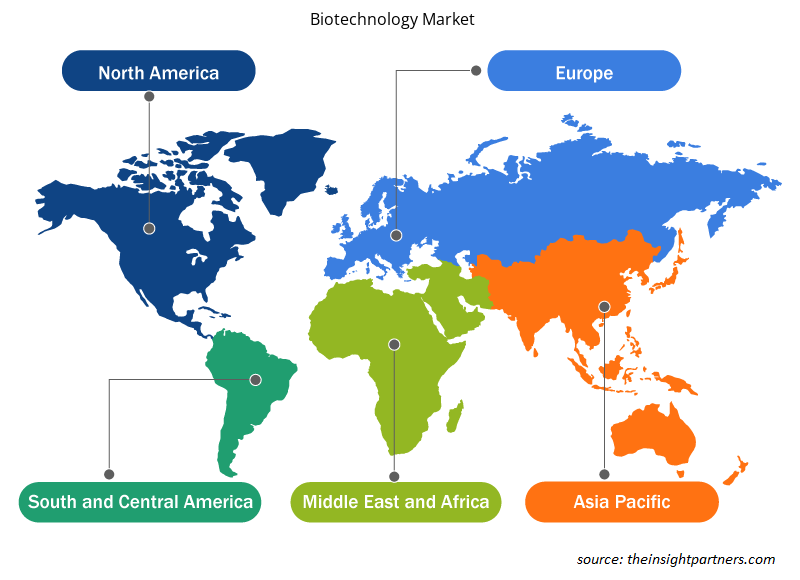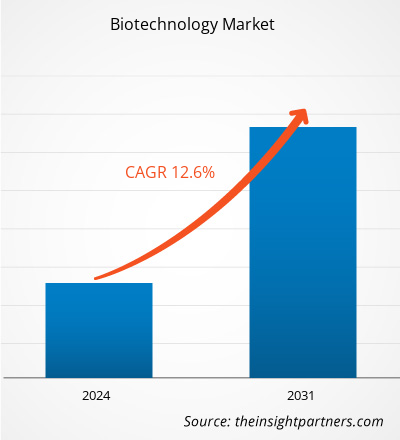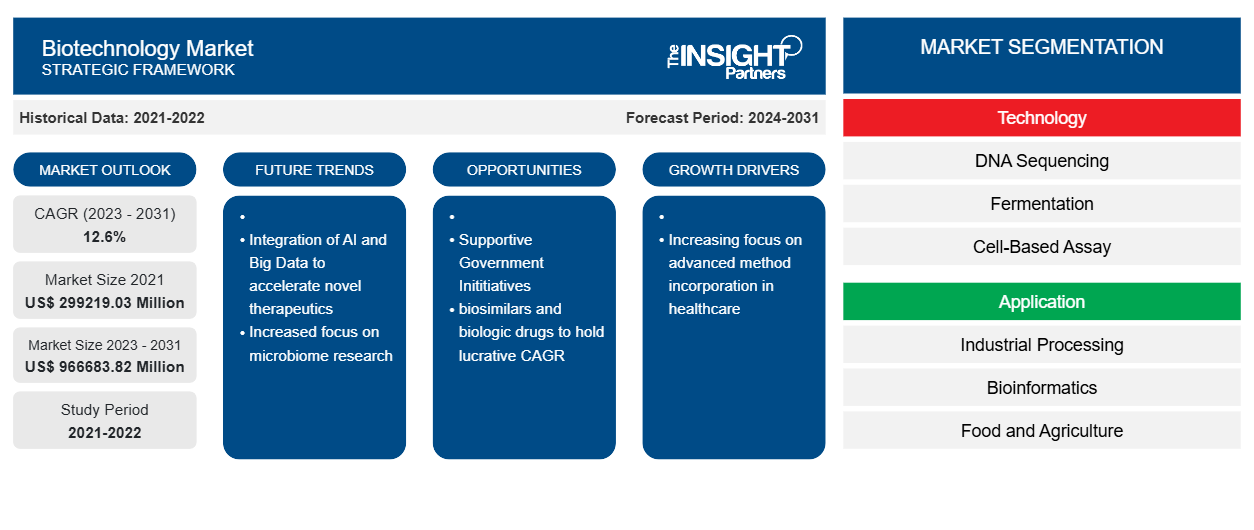El tamaño del mercado de la biotecnología se estimó en 299219,03 millones de dólares estadounidenses en 2021 y XX millones de dólares estadounidenses en 2023 y se espera que alcance los 966683,82 millones de dólares estadounidenses en 2031; se estima que registrará una CAGR del 12,6% hasta 2031. La biotecnología se utiliza en una variedad de aplicaciones que incluyen el procesamiento industrial/bio, la bioinformática, la alimentación y la agricultura, la salud, los recursos naturales y el medio ambiente, entre otros. Además, la biotecnología moderna permite proporcionar innovaciones sobresalientes para productos y tecnologías contra las enfermedades insoportables y raras, también reduce la huella ambiental y alimenta a los hambrientos. Además, utiliza menos energía y más limpia para procesos de fabricación industrial más seguros, limpios y eficientes. Factores como la disminución de los precios de la secuenciación del genoma y el aumento de las tecnologías innovadoras impulsan el crecimiento del mercado de la biotecnología. Además, un número cada vez mayor de iniciativas de organismos privados y gubernamentales también están impulsando el crecimiento del mercado de la biotecnología. Además, es probable que el creciente número de conferencias y talleres sigan siendo tendencias clave del mercado.
Análisis del mercado de biotecnología
La rápida disminución de los costos de la secuenciación del genoma ha sido una fuerza impulsora importante en la transformación y comprensión de la genética clínica, revolucionando el diagnóstico y el tratamiento de enfermedades raras y allanando el camino para la medicina de precisión. El costo de una secuencia del genoma humano disminuyó de aproximadamente $1 millón en 2007 a $1000 en 2014, y es de aproximadamente $600 en la actualidad. El crecimiento del mercado de la biotecnología se debe principalmente a la disminución del precio de la secuenciación del genoma. La adopción sustancial de la secuenciación del genoma por parte de las empresas farmacéuticas y biofarmacéuticas está impulsando el crecimiento del mercado.
Panorama del mercado de la biotecnología
Los expertos en informática y los biólogos utilizan nuevas tecnologías de secuenciación con el objetivo de crear mejores genomas. En los últimos años, han aumentado las tecnologías de software para unir el ADN y las técnicas novedosas para localizar secuencias en los cromosomas. Para apoyar la adopción de nuevas tecnologías con herramientas y técnicas mejoradas, se han establecido varios programas. Por ejemplo, en 1989, se creó el Programa de Secuenciación Genómica del Instituto Nacional de Investigación del Genoma Humano (NHGRI) para abordar las oportunidades científicas actuales en genómica.
El programa de Tecnología Genómica también está apoyando el desarrollo de nuevas tecnologías con métodos e instrumentos mejorados que permiten la determinación rápida y de bajo costo de la secuencia de ADN, experimentos de genómica funcional y genotipado de SNP. El programa de Tecnología Genómica también apoya la transferencia de tecnología de los desarrolladores a los usuarios y ayuda a promover programas multidisciplinarios colaborativos que se incorporen estrechamente a los laboratorios industriales y académicos. Además, muchos actores de la industria han presentado tecnología de NGS innovadora en los últimos años. Por ejemplo, Pacific Biosciences con Sequel y Oxford Nanopore con PromethION. Además, tres sistemas NSG avanzados que dominan el mercado incluyen Roche GS FLX (454), Illumina HiSeq 2000 (Solexa) y AB SOLiD (Agencourt). El avance en la secuenciación del genoma ha hecho que la secuenciación sea fácil y precisa.
Por lo tanto, debido a los avances tecnológicos, se espera que el mercado de la biotecnología crezca a un ritmo rápido durante el período de pronóstico.
El mercado mundial de biotecnología está segmentado por regiones en América del Norte, Europa, Asia Pacífico, Oriente Medio y África, y América del Sur y Central. En América del Norte, Estados Unidos es el mayor mercado de biotecnología. El crecimiento en América del Norte se caracteriza por el aumento de la demanda de productos innovadores de las empresas biofarmacéuticas y biotecnológicas, la presencia de actores clave del mercado y una amplia I+D realizada por varios institutos académicos y de investigación. Además, se espera que los continuos avances tecnológicos estimulen aún más el crecimiento del mercado en América del Norte.
Personalice este informe según sus necesidades
Obtendrá personalización en cualquier informe, sin cargo, incluidas partes de este informe o análisis a nivel de país, paquete de datos de Excel, así como también grandes ofertas y descuentos para empresas emergentes y universidades.
-
Obtenga las principales tendencias clave del mercado de este informe.Esta muestra GRATUITA incluirá análisis de datos, desde tendencias del mercado hasta estimaciones y pronósticos.
Factores impulsores y oportunidades del mercado de la biotecnología
El creciente enfoque en la incorporación de métodos avanzados en la atención médica favorece el mercado de los Estados Unidos
Se espera que el creciente enfoque en la incorporación de métodos avanzados en la atención médica, las iniciativas gubernamentales y privadas para la promoción de la medicina de precisión y los fondos masivos de organismos gubernamentales y privados para la investigación genómica estimulen aún más el crecimiento y contribuyan a la generación de ingresos excepcionales para el mercado de la biotecnología en América del Norte. La biotecnología médica y agrícola ha experimentado revoluciones como resultado de varios programas de desarrollo, estrategias comerciales que ayudan a producir, descubrir o alterar varias biomoléculas y organismos a través de enfoques de bioingeniería. El Departamento de Salud y Servicios Humanos invirtió US$40 millones para expandir el papel de la biofabricación de ingredientes farmacéuticos activos (API), antibióticos y los materiales de partida necesarios para producir medicamentos esenciales y responder a pandemias en 2022. El DoD está lanzando el programa Tri-Service Biotechnology for a Resilient Supply Chain con una inversión de más de $270 millones durante cinco años para convertir la investigación en productos más rápidamente y apoyar el desarrollo avanzado de materiales de base biológica para cadenas de suministro de defensa, como combustibles, compuestos resistentes al fuego, polímeros y resinas y materiales de protección. Es probable que esta necesidad impulse el mercado de biotecnología de los Estados Unidos durante el período de pronóstico.
Iniciativas gubernamentales: una oportunidad para el mercado de la biotecnología
En diciembre de 2023, el Departamento de Biotecnología (DBT) y el Consejo de Asistencia para la Investigación de la Industria Biotecnológica (BIRAC) anunciaron el lanzamiento de 14 nuevos productos basados en biotecnología desarrollados por empresas emergentes y emprendedores en industrias como la atención médica, el diagnóstico, los dispositivos médicos, la agricultura y la biotecnología industrial, durante la tercera edición de Global Bio-India, una mega congregación internacional sobre biotecnología, celebrada en Bharat Mandapam, Pragati Maidan en Nueva Delhi.
Es probable que estos avances de los últimos años generen una atractiva oportunidad de crecimiento para el mercado de la biotecnología.
Análisis de segmentación del informe del mercado de biotecnología
Los segmentos clave que contribuyeron a la derivación del análisis del mercado de biotecnología son el producto y la aplicación.
- Según el producto, el mercado de la biotecnología se segmenta en secuenciación de ADN, fermentación, análisis basado en células, nanobiotecnología, cromatografía, tecnología PCR, ingeniería y regeneración de tejidos y otras tecnologías. El segmento de secuenciación de ADN tuvo la mayor participación del mercado en 2023 y es probable que el mismo segmento crezca a un ritmo más alto durante el período de pronóstico. La secuenciación de ADN es la técnica que se utiliza para determinar el orden específico de las bases de nucleótidos que forman la cadena de ADN. Actualmente es una técnica esencial para muchos de los estudios de investigación básica y aplicada y sus aplicaciones. La técnica de secuenciación de ADN se utilizó en el proyecto del genoma humano, que tardó trece años en completarse y ayudó a comprender la causa de los cambios genéticos en las enfermedades genéticas. La técnica también ayuda a identificar el gen específico que se puede utilizar para diseñar los medicamentos para la enfermedad genética específica. Además, la secuenciación de ADN se utiliza para las pruebas genéticas de paternidad y otras relaciones familiares. Además, la secuenciación de ADN se utiliza para identificar a los sospechosos y víctimas de delitos a través de estudios forenses. Además, las técnicas también tienen un papel importante para analizar las bacterias y otros microorganismos que son responsables de la contaminación del aire, el agua y los alimentos. La secuenciación de ADN se utiliza principalmente para identificar y estudiar las variaciones en diferentes grupos de animales y plantas y sus patrones migratorios para determinar las razas raras para semillas o ganado. Muchas empresas como Thermo Fisher Scientific Inc., Merck KGaA, Illumina, Inc. y varias otras empresas emergentes ofrecen varios kits y reactivos para la técnica de secuenciación de ADN. Por lo tanto, se espera que las ventajas que ofrece la secuenciación de ADN y su uso en las aplicaciones mencionadas anteriormente fortalezcan el crecimiento del segmento en el período de pronóstico.
- Según la aplicación, el mercado de la biotecnología se segmenta en procesamiento industrial, bioinformática, alimentación y agricultura, salud, recursos naturales y medio ambiente, y otras aplicaciones. El segmento de procesamiento industrial tuvo la mayor participación del mercado en 2023; mientras que es probable que el segmento de bioinformática crezca a un ritmo mayor durante el período de pronóstico. El mercado de procesamiento industrial o bioprocesamiento es uno de los campos más prometedores de la biotecnología que está impactando significativamente el mercado de la biotecnología agrícola y de la atención médica y, además, es un nuevo enfoque para la prevención de la contaminación y la conservación de los recursos. El mercado de procesamiento industrial o bioprocesamiento ofrece negocios que ofrecen costos más bajos y crean nuevos mercados al perturbar el medio ambiente. La mayoría de los estudios de laboratorio en biotecnología se realizan para aplicaciones comerciales. Las aplicaciones se utilizan para el descubrimiento y desarrollo de fármacos. Los desarrollos para las proteínas humanas terapéuticas se realizan a través de métodos recombinantes. Por ejemplo, la insulina humana recombinante es el primer medicamento recombinante producido y fue comercializado por Genetech en 1982. El aumento de la prevalencia de la diabetes ha generado enormes beneficios para la insulina recombinante y prevé un crecimiento significativo del mercado de la biotecnología en el futuro. Además, la aplicación del procesamiento industrial incluye la producción de enzimas y microorganismos para fabricar productos de origen biológico en sectores como los químicos, los ingredientes alimentarios, los detergentes, el papel, los textiles, las bebidas, los tejidos, los plásticos, el cuidado personal, los biocombustibles y más.
Análisis de la cuota de mercado de la biotecnología por geografía
El alcance geográfico del informe del mercado de biotecnología se divide principalmente en cinco regiones: América del Norte, Asia Pacífico, Europa, Medio Oriente y África, y América del Sur / América del Sur y Central.
La región de Asia Pacífico es la que registra el crecimiento más rápido en el mercado mundial de la biotecnología. Se espera que el mercado de esta región crezca significativamente en países como China, Japón e India. El crecimiento del mercado se atribuye al creciente enfoque de los actores del mercado en las economías en desarrollo y a las políticas gubernamentales de apoyo.
Perspectivas regionales del mercado de la biotecnología
Los analistas de Insight Partners explicaron en detalle las tendencias y los factores regionales que influyen en el mercado de la biotecnología durante el período de pronóstico. En esta sección también se analizan los segmentos y la geografía del mercado de la biotecnología en América del Norte, Europa, Asia Pacífico, Oriente Medio y África, y América del Sur y Central.

- Obtenga los datos regionales específicos para el mercado de biotecnología
Alcance del informe sobre el mercado de biotecnología
| Atributo del informe | Detalles |
|---|---|
| Tamaño del mercado en 2021 | US$ 299219,03 millones |
| Tamaño del mercado en 2031 | US$ 966683,82 millones |
| CAGR global (2023 - 2031) | 12,6% |
| Datos históricos | 2021-2022 |
| Período de pronóstico | 2024-2031 |
| Segmentos cubiertos |
Por tecnología
|
| Regiones y países cubiertos |
América del norte
|
| Líderes del mercado y perfiles de empresas clave |
|
Densidad de actores del mercado de biotecnología: comprensión de su impacto en la dinámica empresarial
El mercado de la biotecnología está creciendo rápidamente, impulsado por la creciente demanda de los usuarios finales debido a factores como la evolución de las preferencias de los consumidores, los avances tecnológicos y una mayor conciencia de los beneficios del producto. A medida que aumenta la demanda, las empresas amplían sus ofertas, innovan para satisfacer las necesidades de los consumidores y aprovechan las tendencias emergentes, lo que impulsa aún más el crecimiento del mercado.
La densidad de actores del mercado se refiere a la distribución de las empresas o firmas que operan dentro de un mercado o industria en particular. Indica cuántos competidores (actores del mercado) están presentes en un espacio de mercado determinado en relación con su tamaño o valor total de mercado.
Las principales empresas que operan en el mercado de la biotecnología son:
- Novo Nordisk A/S
- Compañía: Moderna Inc.
- BioNTech SE
- Productos farmacéuticos Regeneron Inc.
- Compañía farmacéutica Vertex Inc.
- Productos farmacéuticos Jazz PLC
Descargo de responsabilidad : Las empresas enumeradas anteriormente no están clasificadas en ningún orden particular.

- Obtenga una descripción general de los principales actores clave del mercado de biotecnología
Noticias y desarrollos recientes del mercado de biotecnología
El mercado de la biotecnología se evalúa mediante la recopilación de datos cualitativos y cuantitativos a partir de investigaciones primarias y secundarias, que incluyen publicaciones corporativas importantes, datos de asociaciones y bases de datos. A continuación, se incluye una lista de los avances en el mercado de la biotecnología y las estrategias:
- En abril de 2022, CytoTronics recaudó 9,25 millones de dólares en financiación inicial, liderada por Anzu Partners, con la colaboración de Milad Alucozai (BoxOne Ventures) e inversores institucionales. La empresa utilizó esta financiación inicial para promocionar su innovadora plataforma que utiliza tecnología de chips informáticos para realizar ensayos eléctricos y electroquímicos basados en células (Fuente: CytoTronics, comunicado de prensa, 2022)
Cobertura y resultados del informe sobre el mercado de biotecnología
El informe “Tamaño y pronóstico del mercado de biotecnología (2022-2030)” proporciona un análisis detallado del mercado que cubre las siguientes áreas:
- Tamaño del mercado y pronóstico a nivel global, regional y nacional para todos los segmentos clave del mercado cubiertos bajo el alcance
- Dinámica del mercado, como impulsores, restricciones y oportunidades clave
- Principales tendencias futuras
- Análisis detallado de las cinco fuerzas de Porter y PEST y FODA
- Análisis del mercado global y regional que cubre las tendencias clave del mercado, los principales actores, las regulaciones y los desarrollos recientes del mercado.
- Análisis del panorama de la industria y de la competencia que abarca la concentración del mercado, el análisis de mapas de calor, los actores destacados y los desarrollos recientes
- Perfiles detallados de empresas
- Análisis histórico (2 años), año base, pronóstico (7 años) con CAGR
- Análisis PEST y FODA
- Tamaño del mercado, valor/volumen: global, regional y nacional
- Industria y panorama competitivo
- Conjunto de datos de Excel
Informes recientes
Informes relacionados
Testimonios
Razón para comprar
- Toma de decisiones informada
- Comprensión de la dinámica del mercado
- Análisis competitivo
- Información sobre clientes
- Pronósticos del mercado
- Mitigación de riesgos
- Planificación estratégica
- Justificación de la inversión
- Identificación de mercados emergentes
- Mejora de las estrategias de marketing
- Impulso de la eficiencia operativa
- Alineación con las tendencias regulatorias























 Obtenga una muestra gratuita para - Mercado de la biotecnología
Obtenga una muestra gratuita para - Mercado de la biotecnología